Abstract
Objective:
To determine the effect of a 6-week leg press training program on quadriceps femoris peak torque and lower extremity functional performance.
Design and Setting:
A 2 x 3 factorial design. A private university-based outpatient physical therapy clinic was used for testing. The university strength and conditioning center was used for training sessions.
Subjects:
A volunteer sample of thirty nonathletic, collegeage females participated. All thirty subjects completed the study.
Measurements:
Subjects were randomly assigned to either a control group (Gcon) or an exercise group that performed isotonic unilateral leg presses through either 0 to 60° (G60) or 0 to 90 ° (G90) of knee flexion. Subjects trained 3 days/wk for 6 weeks using the DAPRE technique. Pre and post isokinetic testing of the quadriceps femoris at 60°/sec and hop tests for distance and time were measured.
Results:
Both training groups showed significant pre-post increases (p < .05) for: concentric peak torque, eccentric peak torque, and hop test for distance. G\60 showed a significant decrease in hop test for time values. Significant increases (p < .05) in eccentric peak torque was seen between training groups and the control group, concentric peak torque was significantly greater only in G90 as compared to Gcon, on. No significant differences were observed between G60 and G90 for any of the measured variables. There were no differences between the three groups for any of the functional hop test measurements.
Conclusions:
Unilateral leg press exercise performed through 0 to 90° of knee flexion increases concentric and eccentric peak torque while training from 0 to 60° improves eccentric torque. No changes in functional performance as measured by hop tests were seen in any groups. Transference between closed kinetic chain (CKC) exercise and open kinetic chain testing was supported, but not between CKC and functional performance testing.
Keywords: closed kinetic chain exercise, leg press, functional testing, isokinetic testing
Full text
PDF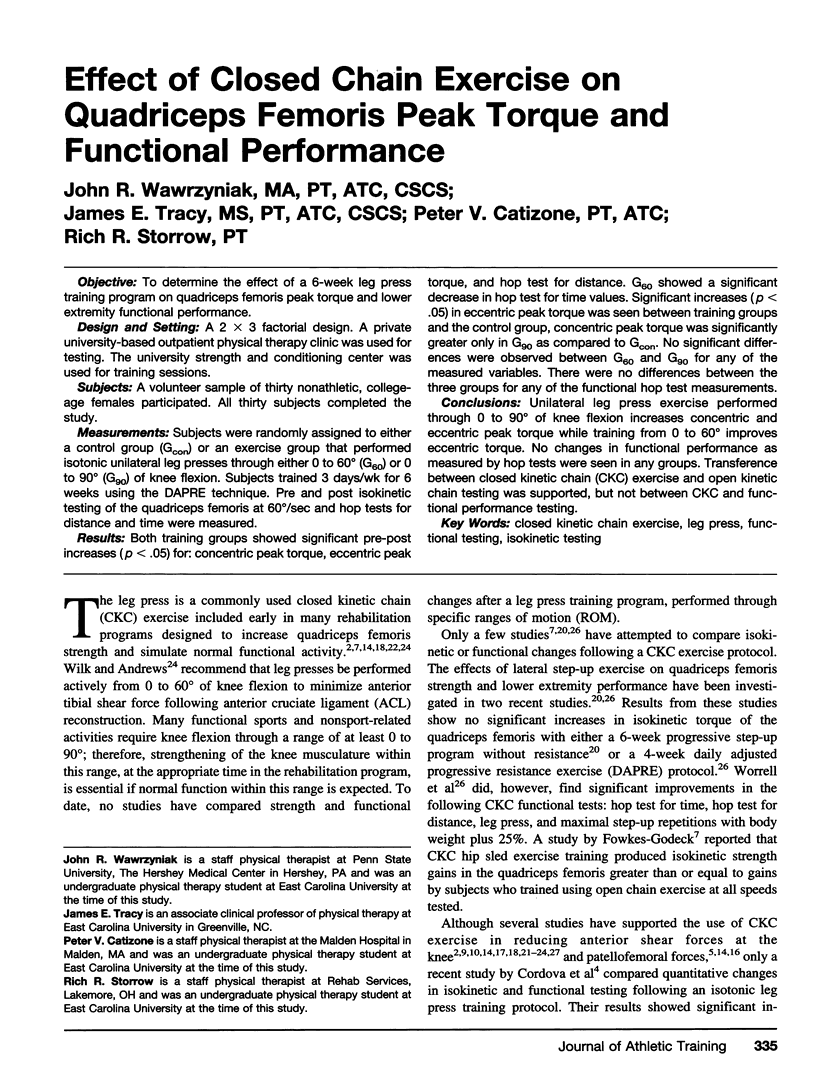
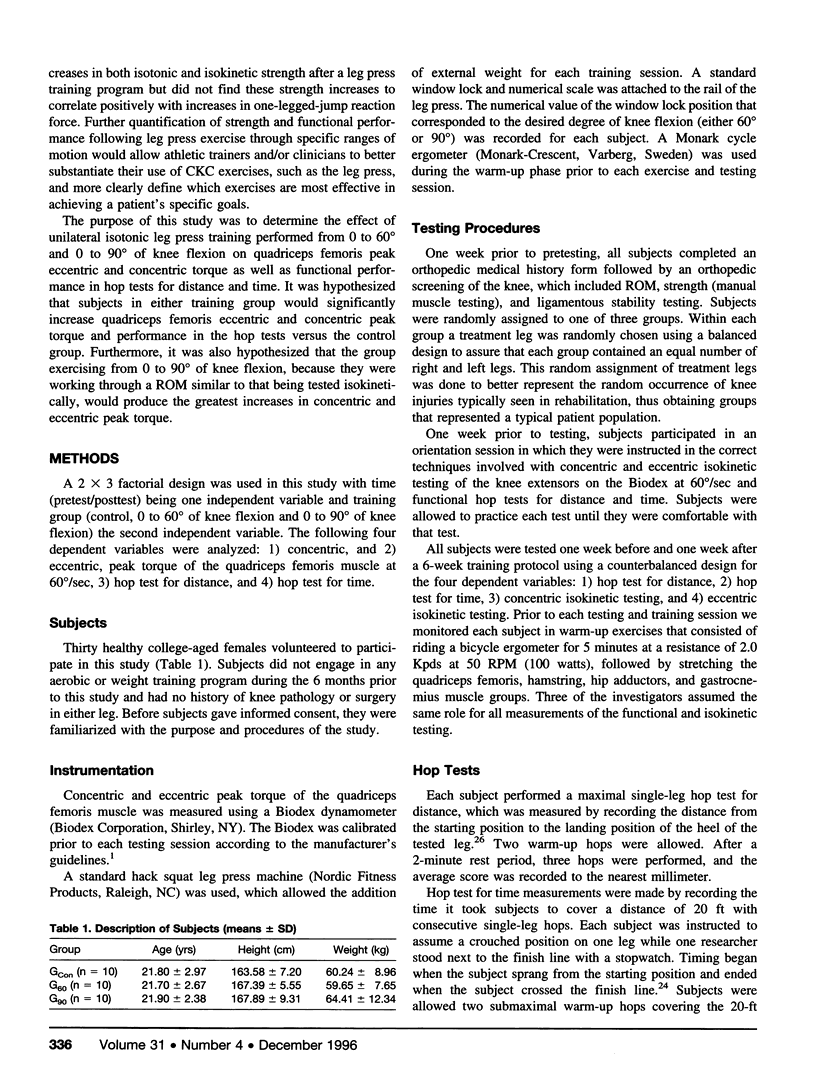
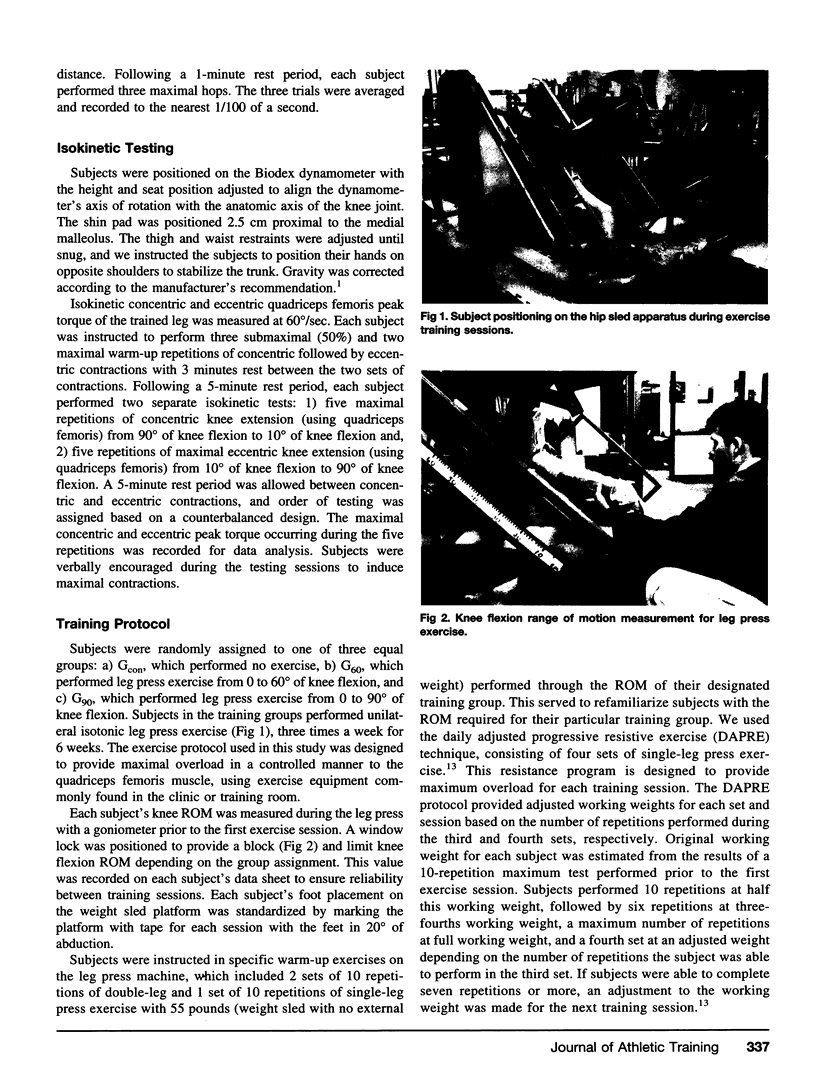
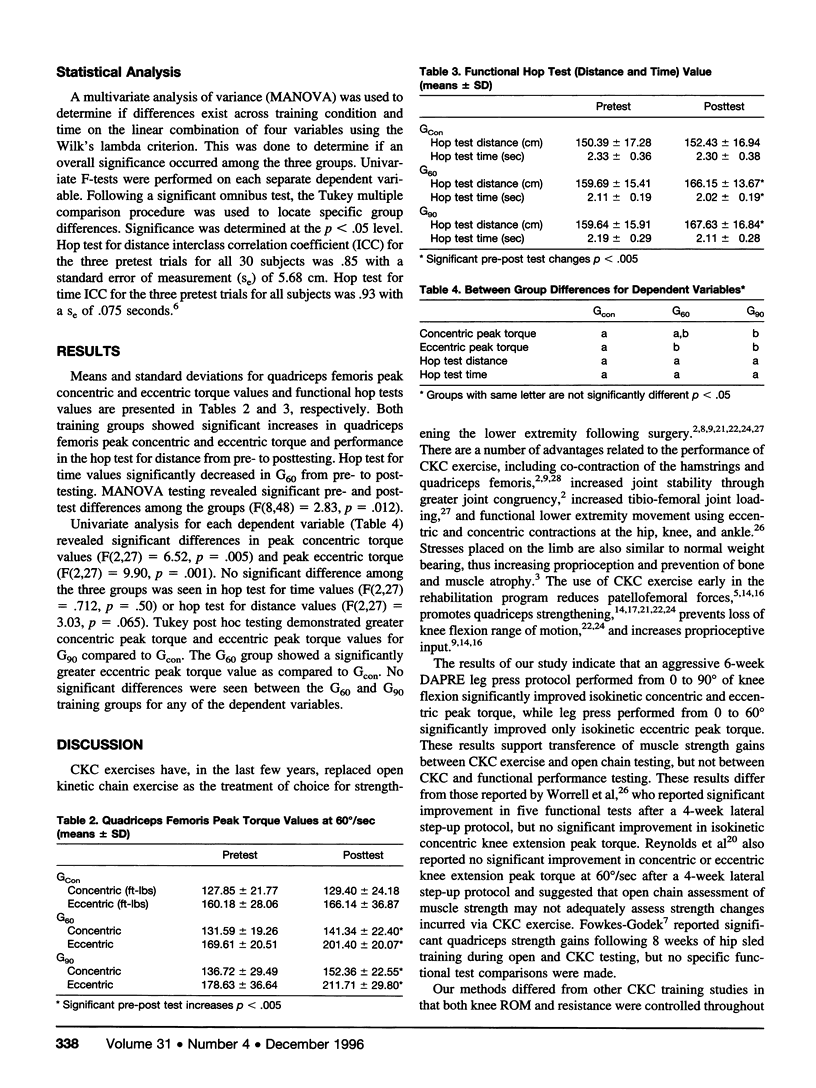
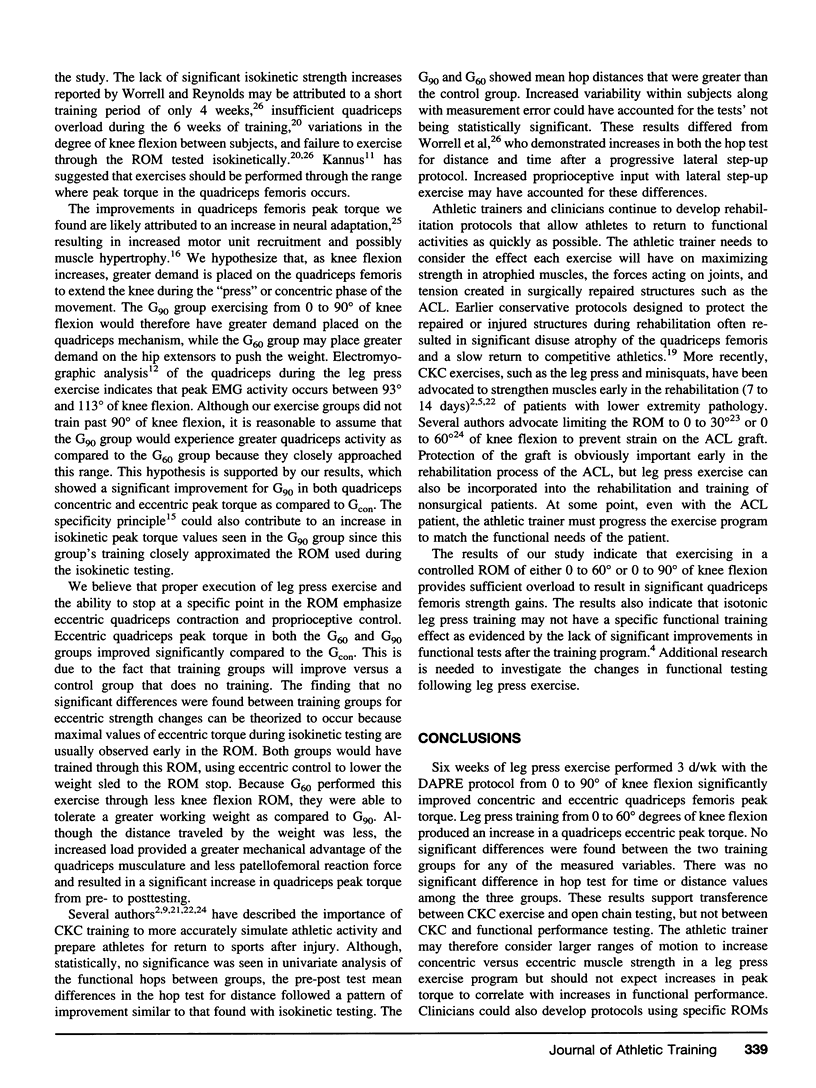
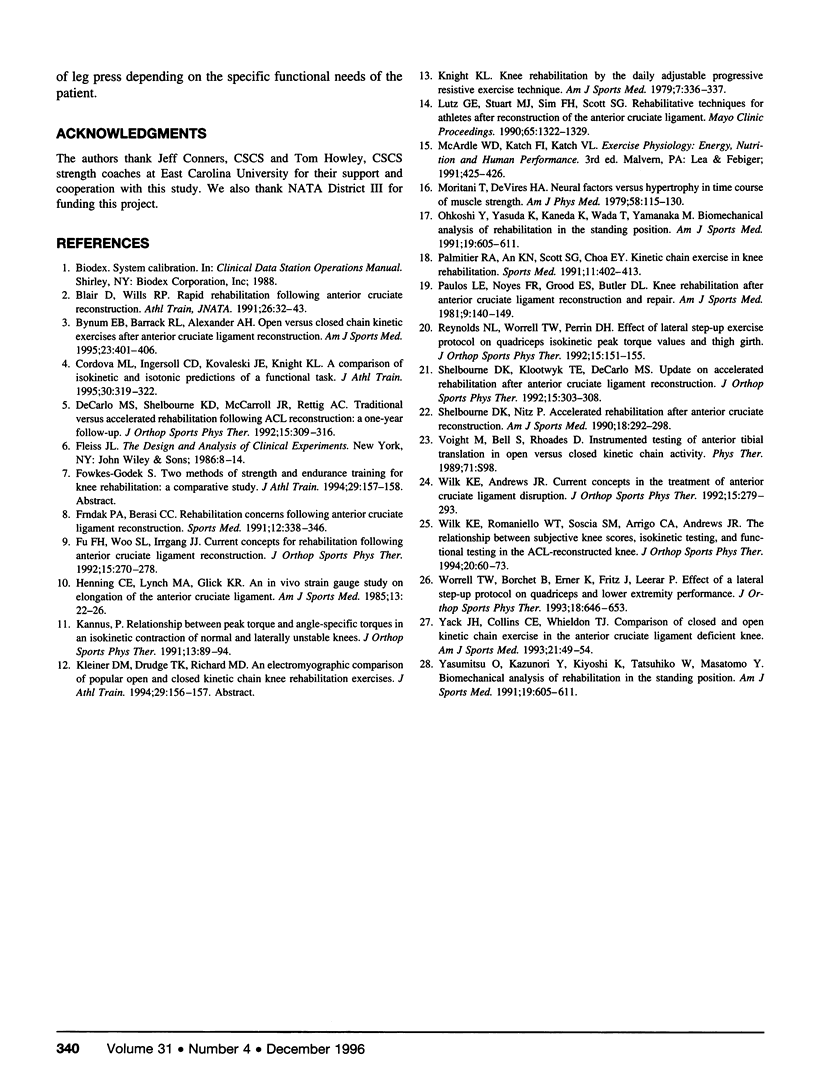
Images in this article
Selected References
These references are in PubMed. This may not be the complete list of references from this article.
- Bynum E. B., Barrack R. L., Alexander A. H. Open versus closed chain kinetic exercises after anterior cruciate ligament reconstruction. A prospective randomized study. Am J Sports Med. 1995 Jul-Aug;23(4):401–406. doi: 10.1177/036354659502300405. [DOI] [PubMed] [Google Scholar]
- Cordova M. L., Ingersoll C. D., Kovaleski J. E., Knight K. L. A comparison of isokinetic and isotonic predictions of a functional task. J Athl Train. 1995 Oct;30(4):319–322. [PMC free article] [PubMed] [Google Scholar]
- Frndak P. A., Berasi C. C. Rehabilitation concerns following anterior cruciate ligament reconstruction. Sports Med. 1991 Nov;12(5):338–346. doi: 10.2165/00007256-199112050-00006. [DOI] [PubMed] [Google Scholar]
- Henning C. E., Lynch M. A., Glick K. R., Jr An in vivo strain gage study of elongation of the anterior cruciate ligament. Am J Sports Med. 1985 Jan-Feb;13(1):22–26. doi: 10.1177/036354658501300104. [DOI] [PubMed] [Google Scholar]
- Knight K. L. Knee rehabilitation by the daily adjustable progressive resistive exercise technique. Am J Sports Med. 1979 Nov-Dec;7(6):336–337. doi: 10.1177/036354657900700605. [DOI] [PubMed] [Google Scholar]
- Lutz G. E., Stuart M. J., Sim F. H., Scott S. G. Rehabilitative techniques for athletes after reconstruction of the anterior cruciate ligament. Mayo Clin Proc. 1990 Oct;65(10):1322–1329. doi: 10.1016/s0025-6196(12)62143-0. [DOI] [PubMed] [Google Scholar]
- Moritani T., deVries H. A. Neural factors versus hypertrophy in the time course of muscle strength gain. Am J Phys Med. 1979 Jun;58(3):115–130. [PubMed] [Google Scholar]
- Ohkoshi Y., Yasuda K., Kaneda K., Wada T., Yamanaka M. Biomechanical analysis of rehabilitation in the standing position. Am J Sports Med. 1991 Nov-Dec;19(6):605–611. doi: 10.1177/036354659101900609. [DOI] [PubMed] [Google Scholar]
- Ohkoshi Y., Yasuda K., Kaneda K., Wada T., Yamanaka M. Biomechanical analysis of rehabilitation in the standing position. Am J Sports Med. 1991 Nov-Dec;19(6):605–611. doi: 10.1177/036354659101900609. [DOI] [PubMed] [Google Scholar]
- Palmitier R. A., An K. N., Scott S. G., Chao E. Y. Kinetic chain exercise in knee rehabilitation. Sports Med. 1991 Jun;11(6):402–413. doi: 10.2165/00007256-199111060-00005. [DOI] [PubMed] [Google Scholar]
- Shelbourne K. D., Nitz P. Accelerated rehabilitation after anterior cruciate ligament reconstruction. Am J Sports Med. 1990 May-Jun;18(3):292–299. doi: 10.1177/036354659001800313. [DOI] [PubMed] [Google Scholar]
- Wilk K. E., Romaniello W. T., Soscia S. M., Arrigo C. A., Andrews J. R. The relationship between subjective knee scores, isokinetic testing, and functional testing in the ACL-reconstructed knee. J Orthop Sports Phys Ther. 1994 Aug;20(2):60–73. doi: 10.2519/jospt.1994.20.2.60. [DOI] [PubMed] [Google Scholar]
- Worrell T. W., Borchert B., Erner K., Fritz J., Leerar P. Effect of a lateral step-up exercise protocol on quadriceps and lower extremity performance. J Orthop Sports Phys Ther. 1993 Dec;18(6):646–653. doi: 10.2519/jospt.1993.18.6.646. [DOI] [PubMed] [Google Scholar]
- Yack H. J., Collins C. E., Whieldon T. J. Comparison of closed and open kinetic chain exercise in the anterior cruciate ligament-deficient knee. Am J Sports Med. 1993 Jan-Feb;21(1):49–54. doi: 10.1177/036354659302100109. [DOI] [PubMed] [Google Scholar]




